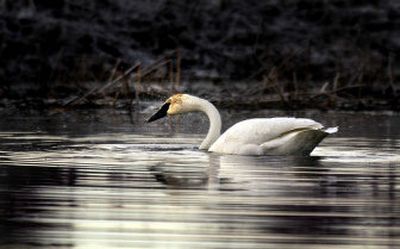Senior swan

Solo is back, but this time he’s not alone. The elegant trumpeter swan is perhaps the elder seasonal wildlife resident at Turnbull National Wildlife Refuge, and one of the oldest ever documented anywhere among his endangered species. For decades, Solo has returned each spring to Turnbull. He’s flown high with the success of raising a family and suffered the lows of losing at least two mates. But Turnbull continues
to be his home as soon as the ice comes off in March and he stays until freeze-up.
“We know he must winter fairly close by because he was back in the middle of winter when we had a thaw and then he left when it froze again,” said Nancy Curry, refuge manager. “But then in March when it thawed again, here he came up the creek, trumpeting away as if to say, ‘I’m baaack!’ “
The trumpeter’s namesake call is unforgettable, similar to the rasping horn of an old-fashioned French taxi.
While tundra swans commonly stop at the refuge during migrations, groups of the larger trumpeters are a much rarer sight in the region.
Except for Solo.
And this year, he’s brought back an immature swan, still grayish with a pink beak.
“Everybody’s calling the young swan a “she,” but nobody knows for sure,” Curry said.
“It’s really unusual because swans usually stick together in tight family groups until the next year’s nesting,” said Mike Rule, refuge biologist. “This swan was hatched last year, so we don’t have any idea how it hooked up with the old male.”
The swans occasionally can be found at Winslow Pond, which is just Solo’s old nesting area south of the refuge headquarters area, a convenient viewing spot for visitors looking for a glimpse of an endangered species. More often they’ve been south of Winslow at Cheever Lake (formerly called Lower Pine).
In the past, Solo wasn’t so obvious. He was just one of the crowd.
In 1963, six trumpeter cygnets were brought to Turnbull from Red Rock Lakes National Wildlife Refuge in Montana. Another 31 cygnets were introduced from 1965 through 1966.
The first successful nesting on the refuge was in 1967, when a pair produced four cygnets. By 1970, trumpeters had eight nests on the refuge, producing 16 cygnets, 11 of which fledged. Solo apparently was hatched sometime during that three-year period, Rule said.
The refuge had installed a cyclone fence with barbed wire across the top to protect the flock. However, the special treatment for swans at the refuge faded in 1976.
“We used to aerate the display pond and provide supplemental feed,” Rule said. “A decision was made to stop that and go to a more natural situation, forcing the birds to migrate.
“That was a disaster for the trumpeters. The birds dispersed and mortality increased significantly. Adult birds got lost and pairs broke up and few birds returned to the refuge.”
Four adult trumpeters banded in August of 1978 were seen near Prineville, Ore., in December of that year. The last recorded citing of the young produced by those birds was two years later near Revelstoke, British Columbia.
Since Solo shows up at the refuge as soon as the ice breaks up each year, Rule suspects that he might be wintering at one of the area’s big lakes or possibly the Spokane River.
By the mid-1980s, the fencing was gone from Winslow Pond, and Solo and his mate were the only pair returning. The one cygnet they fledged in 1984 was the last to be produced on the refuge, even though the pair tried to nest in the next four years until the female was killed, apparently by a coyote, in 1988.
Solo returned with another mate in 1994 and they made lame attempts to be productive again until the female disappeared in 1998.
“We think he was just too old,” Curry said.
Solo was captured in 1979 — 27 years ago — but since its original leg band apparently had fallen off, he was simply identified as being “at least 3 years old,” according to refuge records.
That means Solo is at least 30, but there’s a possibility he’s much older, Rule said, noting there’s a chance that he’s one of the first cygnets produced on the refuge.
That would make him as old as 38, about six years older than the maximum life-span trumpeters are known to reach. In the wild, typical survival age for trumpeters ranges from 15-25 years, according to researchers at Yellowstone National Park.
Either way, Solo is one of the refuge’s most distinguished seniors, and perhaps it’s one of the region’s bragging rights that a dignitary with his range in all that wild blue yonder chooses our backyard to ride out his golden years.